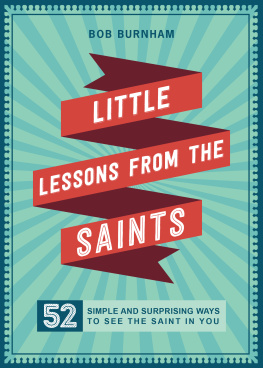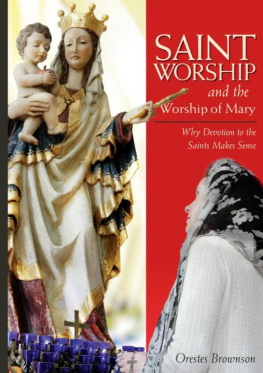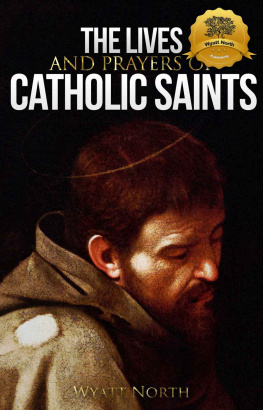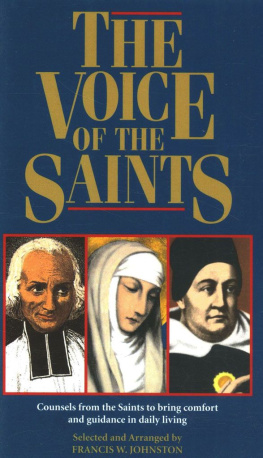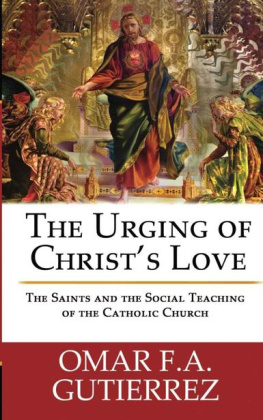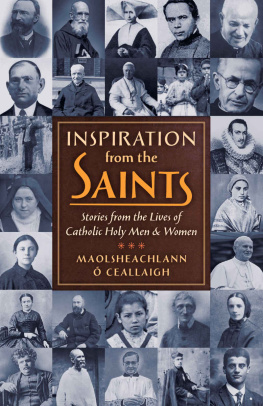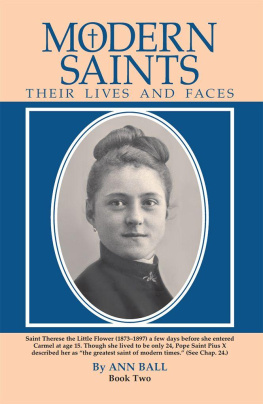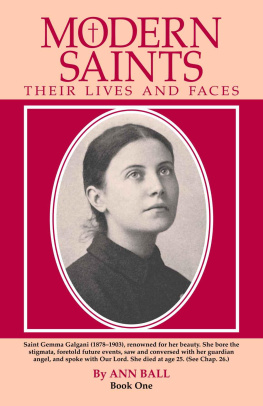SAINTS SANTOS SHRINES
Written and photographed by John Annerino

SAINTS SANTOS SHRINES
Digital Edition 1.0
Text 2013 John Annerino
Photographs 2013 John Annerino
All rights reserved. No part of this book may be reproduced by any means whatsoever without written permission from the publisher, except brief portions quoted for purpose of review.
Gibbs Smith
P.O. Box 667
Layton, Utah 84041
Orders: 1.800.835.4993
www.gibbs-smith.com
ISBN: 978-1-4236-3141-5
For my editor, Madge Baird, who brought this wonderful project to me,
For Wendover H. Brown, who first showed me the camino to photographing devotional art,
For my vida Alejandrina, who shared her Spanish traditions,
And for my mother, who always kept the candles burning.
BOOKS BY THE AUTHOR
The Virgin of Guadalupe: Art and Legend
Indian Country: Sacred Ground, Native Peoples
Vanishing Borderlands: The Fragile Landscape of the U.S./Mexico Border
Desert Light: A Photographers Journey through Americas Desert Southwest
Canyon Country: A Photographic Journey
Grand Canyon Wild: A Photographic Journey
Apache: The Sacred Path to Womanhood
Roughstock: The Toughest Events in Rodeo
People of Legend: Native Americans of the Southwest
The Wild Country of Mexico: La tierra salvaje de Mxico
Canyons of the Southwest: A Tour of the Great Canyon Country from Colorado to Northern Mexico
High Risk Photography: The Adventure Behind the Image
New Mexico: A Photographic Tribute
Arizona: A Photographic Tribute
The Photographers Guide: To the Grand Canyon
The Photographers Guide: To Canyon Country
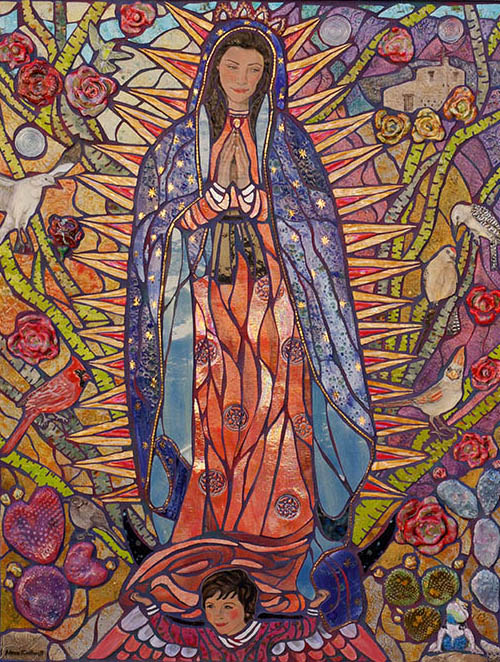
Our Lady of Guadalupe handmade and hand-painted tile mosaic by Ginny Moss Rothwell, Tucson, Arizona. / Nuestra Seora de Guadalupe azulejo de mosaico pintado y hecho a mano por Ginny Moss Rothwell, Tucson, Arizona.
ACKNOWLEDGMENTS
This wonderful project came to fruition through the talents of my editor Madge Baird, book designer Tracy Sunrize Johnson, design assistant Melissa Dymock, and production editor Renee Bond at publisher Gibbs Smith, and my wife, translator, and confidant, Alejandrina Sierra.
Many kind people, artists, and collectors opened their doors to my inquisitive eyes for the devotional art, folklore, and history. Among them, Lance Laber, Executive Director of the DeGrazia Foundation and Gallery in the Sun, who painted a tapestry of the art and life of Ettore Ted DeGrazia in the foothills of the Santa Catalina Mountains; the multicultural community of San Xavier del Bac Mission, Jesuit Fathers of Southern Arizona; photographer and filmmaker Oscar Hermn Sanz; artist and collector Ronald MacBain; private collectors Mara Garca, Angela Lpez, and Josefina Lizarraga; and artist Ginny Moss Rothwell. I am also grateful to my friend Lucinda Bush, and her sister Marisa Bush, for coordinating my photographic pilgrimage to the Our Lady of Guadalupe Basilica in Mexico City. Thanks to R. James Hills, who first introduced me to the art, people, and lifeways of the Comcac (Seri people) of Desemboque, Sonora. And to ngel Paco Fierro Gil for guiding me through a wild barranca in Mexicos Sierra Tarahumara.
Santero Adn Ulivarri Carriaga invited me to his home studio in Plaza Vieja, Albuquerque, New Mexico, to photograph his work and collection of santos and retablos in his familys Holy Child of Atocha Oratory produced by master santeros Pedro Antonio Fresqus, Jos Arragn, Charles M. Carrillo, Alcario Otero, Gustavo Victor Goler; master santera Arlene Cisneros Sena; santeros Mark Garca, Nicolas R. Otero, Fedencio Prudencio, Jimmy E. Trujillo; and santeras Marie Antoinette Luna and Jenina Carriaga-Lambert.
My travels for this book culminated in a rare visit with ninety-year-old master santero Eulogio Ortega in his home chapel of Our Lady of Guadalupe in the mountains of Velarde, New Mexico, which hosts an extraordinary altar retablo carved by him and painted by his late wife, master santera Zoraida Ortega.
Thank you.
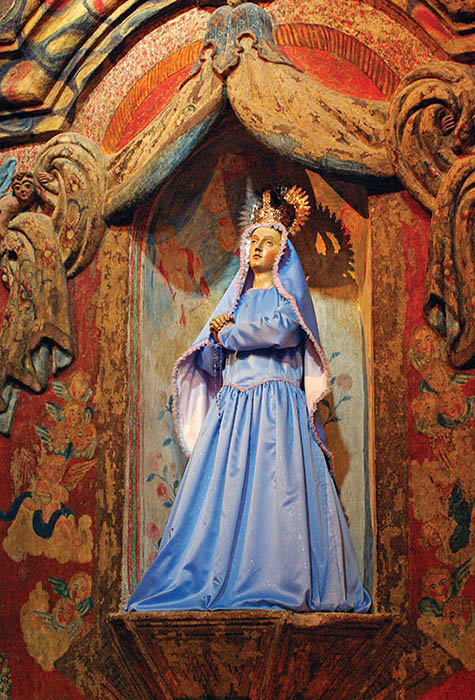
The Sorrowing Mother, east transept, San Xavier del Bac Mission, Arizona. / Nuestra Seora de los Dolores, transepto este, Misin de San Xavier del Bac, Arizona.
HALLOWED PASSAGES
This little mission of San Xavier del Bac, seemed an oasis in the great barren wastes, that stretched out for miles and miles around it, whichever way one turned. It is the prettiest part of the Santa Cruz valley... as perfect as nature ever gave even in this latitude... here, during the thirty past years of his mission work, Father Kino had done a noble work. [] |
| Marian Calvert Wilson, 1891, Manuelita: The Story of San Xavier del Bac |
It is a bright September day that holds the promise of good things to come. The wind is warm. The sky is deep blue. And the sweep of black lava desert, tinged with gold from the afternoon sun, stretches for miles and miles around me, whichever way I turn. Bristling with forests of saguaro, cholla, and prickly pear cactus, the mesquite, palo verde, and ironwood trees are brimming with vibrant green leaves from torrential summer monsoons. Cottontail rabbits hop along from bush to bush, while coveys of quail and white-winged dove scurry on foot at my approach. Lizards dart here and there as my feet crunch along the stony path that winds for miles toward thirty-foot-tall sentinels of saguaro. Home to the cactus wren and gila woodpecker, the saguaro is revered by local Native peoples. The Tohono Oodham, People of the Desert, harvest red fruit from the Ha:san each summer and gather the sweet bounty in handmade baskets woven from devils claw.
I keep walking, with an eye toward Black Mountain, which beckons in the distance. Some say that because the mountain is rich in iron, it attracts the most spectacular lightning strikes and thunderstorms in the Southwest. Today, it is a quiet and elegant form, shimmering with delicate heat waves that slalom through fluted columns of saguaro. This was the dreamy mirage pilgrims floated through toward the Moorish-style Spanish mission once called the White Dove in the Desert. I was among them.
I have been journeying on foot across the desert toward the ancient mission for many miles. I have made a manda (a religious plea, or prayer of thanks) to experience for a few hours the hardships Jesuit Padre Eusebio Francisco Kino endured when he visited the village of Bac, place where the water appears, in 1692. Here, near the banks of the Santa Cruz River, Padre Kino laid the groundwork for Mission San Xavier del Bac. It was no small task during his prodigious desert journeys. Between 1693 and 1701, the indefatigable missionary, explorer, cartographer, and cattleman traveled an estimated 7,500 miles of unexplored trails across the harshest reaches of southern Arizona and northern Sonora, Mexico, pioneering the merciless border route across El Camino del Diablo, The Road of the Devil, in quest of souls and a land route to California. But Padre Kino wore leather sandals on his calloused feet when he strode, or rode horseback, far and wide from mission to mission across the thorn-scaped Sonoran Desert borderlands. My tender feet are comforted in footwear that shields them from the spines, stones, and comparatively minor rigors of my journey.




